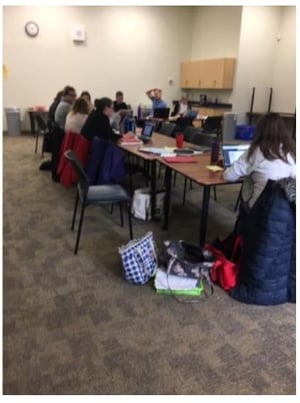This is part two of Amy Smith’s Blog The Road to Equity: How do you define equity? In part one she discussed her own learning journey of gaining additional knowledge about groups identified as in need of more support in schools in the equity and inclusion branch of Peel Board’s five year School Success Plan. All of her reading and learning encouraged her “to really reflect on the life I was living, and the privileges I have that I was not even aware of simply because I was born in a white, abled, cisgender body.” In part two she will cover how she took her own learning and expertise to help other educators start their journey, to start learning about who they are as people and how their privilege and bias impacts their students.
In order to help educators start down this path, I started with the Culturally Responsive Pedagogy Monograph and decided to focus on the Culturally Responsive Characteristics.
Characteristic #1 Socio-cultural consciousness: An awareness of how socio-cultural structures impact individual experiences and opportunities.
Characteristic #2 High expectations: Hold positive and affirming views of all students of all backgrounds.
Characteristic #3 Desire to make a difference: See themselves as change agents working towards more equity.
Characteristic #4 Constructivist approach: Understand that learners construct their own knowledge.
Characteristic #5 Deep knowledge of their students: Know about the lives of students and their families; know how students learn best and where they are in their learning.
Characteristic #6 Culturally responsive teaching practices: Design and build instruction on students’ prior knowledge in order to stretch students in their thinking and learning.
I realized very quickly that exploring all six with educators was an overwhelming and impossible task. Educators are very busy and I wanted them to slow down for a minute and really think about who they are as people and how their privilege and bias was impacting their students. Easy right? I decided to focus my attention on Characteristic One, and knowing that as educators our own learning journey immediately impacts our students, Characteristic Five was a natural partner. I created a graphic organizer to help guide educators reflection. The goal was for educators to reflect on the criteria to determine an area of focus for their inquiry. The details in bold were some suggestions for where to get started.
The difficult part was convincing administrators and educators that the first goal was about their own learning not specifically about changes in the classroom. I reached out to administrators who I support in my role as instructional coach and had a lot of positive response. After reflection, Tomken Road Middle School’s leadership team agreed to participate in the Inquiry. We would begin our journey with a full day release.
The day was broken into three parts; getting to know themselves, their students, and the logistics of the year long collaborative inquiry (CI).
We started our morning with a how well do you know your neighbour Kahoot! Because who doesn’t love Kahoot? This team has worked together for a couple of years and it was interesting how they thought they knew so much about each other but still learned new details about colleagues.
The next step was to establish terms and definitions for the purpose of our collaborative inquiry. The terms bias, privilege, and equity are used a great deal right now and I have found one of the obstacles to this work is that everyone has a different definition of the word. For the purpose of this CI we defined our terms as followed
Positionality - who I am within the classroom, school, board
Privilege - the power I have from the body I move through the world in, how I am perceived by others, the power I have to influence the students I serve
Bias - what I bring into the classroom, or exclude from the classroom is linked to my lived experience and my understanding of the world around me
Equity - the four communities specifically identified in the Plan for Student Success, black students, students living in poverty, LGBTQ+ students, First Nation, Metis, and Inuit students
This activated great group discussion around who has a voice in our schools and our classrooms. Dealing with the privilege we have is sometimes difficult to face especially when we reflect on situations where maybe we benefited without really being conscious of it.
 Educators wrote I Am From poems using the following prompts: three people from your childhood, three phrases from your childhood, three foods from your childhood, three childhood memories, vacations, holidays, celebrations from your childhood. These poems opened up free dialogue about parents and values that educators had not only not shared before, but also may not have reflected on how these factors have shaped who they are as a person and as an educator. Educators in the room could see how these activities would allow them to get to know their students beyond what they showed them in the classroom. This could be adapted to a community circle activity.
Educators wrote I Am From poems using the following prompts: three people from your childhood, three phrases from your childhood, three foods from your childhood, three childhood memories, vacations, holidays, celebrations from your childhood. These poems opened up free dialogue about parents and values that educators had not only not shared before, but also may not have reflected on how these factors have shaped who they are as a person and as an educator. Educators in the room could see how these activities would allow them to get to know their students beyond what they showed them in the classroom. This could be adapted to a community circle activity.
Then I simply gave educators time to learn and talk. I provided a series of resources either electronically or in hard copy and educators selected which community they wanted to learn about and they took some time to learn. Some were watching documentaries on indigenous students in Thunder Bay, some were reading articles around LGBTQ+ students in sports. As educators read I had them share their learning on a mentimeter that ran live on the screen.
.jpeg?width=960&name=Untitled%20presentation%20(1).jpeg)
.jpeg?width=960&name=Untitled%20presentation%20(2).jpeg)
As we gathered together to share our learning I heard the phrase “I didn’t know...” and “Did you know?” repeated several times. This moment confirmed for me that life is so busy that there is no way we can pay attention to it all, even for educators who are open to new learning and interested in equity and social justice. I found this open sharing was a very effective way to provide educators with facts regarding the four communities identified in our Plan for Student Success because they are not experiencing success in our schools. If nothing else these educators walked away from their day understanding a little bit of the lived experiences of the students in those communities which I think will make them more reflective and intentional with their practice.
I have found doing equity work that when push back occurs it is often because we can find an exception to the data. Phrases like “I have a black friend and they say that is not what they experienced in school” are used to push back against the difficult learning that some are facing. In the afternoon of our time together I shared the TEDX talk by Paula Stone, a transgender women who shares her experiences navigating the world as a man and as a woman. I used this video to support the idea of “Believe Us.” When someone shares their narrative do not be so quick to example it away. Believe that this is their perspective, believe that this is their lived experience, believe.
Some of the text from the big paper activity (pictured left): “In order to ensure that all students feel safe, welcomed, accepted and inspired to succeed in a culture of high expectations for learning, school and classrooms must be responsive to culture.”
Following this discussion the educators participated in the Silent Conversation protocol, or Big Paper, a strategy I learned from Facing History. Educators moved around the room investigating provocations and having conversations with colleagues in written form. I selected this strategy because I knew some of the prompts could get emotional and I thought adding writing time would help to defuse the emotion. I have used this strategy in the classroom as well when I thought students would benefit from extra processing time.
For the last portion of the day I reviewed the expectations for the inquiry and the responsibilities for the educators to participate. Before they left for the day they were required to submit a Google form identifying the equity community they were going to learn about. This was a way for me to know what their focus was so I could support their learning along the way. It was a day full of challenging conversations and shifting thinking but I believe everyone walked away with a new perspective inspired to continue with their own learning. I look forward to our next meeting where educators will share their learning journeys.
Next Steps
How are you engaging in difficult conversations with students and colleagues?
How are you pushing your learning forward to understand the lived experiences of the students you serve?

